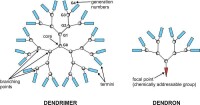樹枝狀大分子
樹枝狀大分子
樹枝狀大分子是由重複增長反應合成而來的,高度支化且結構精確的分子。每一個重複循環反應增加一個支化層,叫做“代”。它包括主結構(內核,支化單元,外圍基團)及微環境(空腔)。
英文名dendrimer,中文名稱分前綴和主語,前綴有9種之多:樹形、樹狀、樹枝形、樹枝狀、樹型、樹枝型、樹枝、樹突、枝狀,主語有7種之多:化合物、分子、大分子、高分子、聚合物、聚體、聚合體,排列組合有至少63種名稱,如無特別註明,後文中統稱為樹枝狀分子。國內僅威海晨源生產。

dendrimer and dendron
精確的分子結構;
高度的幾何對稱性;
外圍大量的官能團;
分子內存在空腔;
分子量可控;
分子本身具有納米尺寸。
良好的流體力學性能;
黏度隨分子量的增加出現最大值;
容易成膜;
多功能性;
不易結晶;
粘度隨分子量的增加出現最小值;
有較強吸附能力,可作為金屬離子的載體
一般分別為發散合成法、收斂合成法、發散收斂結合法。
發散合成是從所需的樹狀大分子的中心點開始向外擴展來進行合成反應的。從中心核開始,該中心核擁有一個或多個反應點,然後用帶有分支結構的單元與中心核反應,即得到了第一代分子。將第一代分子分支末端的官能團轉化為可繼續進行反應的官能團,然後重複與分支單元反應物進行反應則得到第二代分子。不斷重複以上的兩個步驟,就可以得到期望的樹狀大分子。
優點是化合物增長過程中反應點逐漸增多,可以合成較高的代數; 缺點是末端官能團反應不完全將會導致下一級產物產生缺陷,而且隨著分子的增大這種現象出現的機會也就越大。
收斂法是由樹枝形聚合物的外圍逐步向內合成的方法。反應是由將要生成樹枝形聚合物最外層結構的部分開始,然後與分支單元反應物反應得到第一代分子;之後將基團活化后再與分支單元反應物繼續反應得到第二代分子。如此不斷地重複將基團活化,並與分支單元反應物進行連接,就可合成出更高代數的樹枝形聚合物。
與發散合成相比,其優點為:收斂合成涉及的每步增長過程中反應官能團數目要少一些,使每一步反應總是限制在有限的幾個活性中心進行,避免了採用大為過量的試劑,並降低了由於反應不完全產生“疵點”的幾率,產物的結構也更加精緻,同時純化和表徵也容易。
缺點為:對立體位阻比較敏感,隨著樹狀大分子的增長,反應官能團活性減小,反應產率也會下降,且合成的高分子沒有發散法合成的大。
發散收斂結合法是先用發散法製備出低代數的樹狀分子,作為活性中心,再用收斂法製得一定代數的扇形分子,稱為“支化單體”,然後再將“支化單體”接到活性中心上就可合成出樹狀大分子。發散收斂結合法綜合了發散法和收斂法的優點,既能使合成產率提高,分子量增長加快,又能使分離純化變得簡單,減少分子結構缺陷。
1.Dendrimers are repeatedly branched molecules. The huge number of papers on dendritic architectures such as dendrimers, dendronized, hyperbranched and brush-polymers has generated a vast variety of inconsistent terms and definitions making a clear and concise unfolding of this topic highly difficult. The purpose of this section is to provide the vocabulary required for the description of chemical and physical phenomena as well as application aspects associated with the research in the area of dendritic molecules.
Dendritic molecules are repeatedly branched species that are characterized by their structure perfection. The latter is based on the evaluation of both symmetry and polydispersity. The area of dendritic molecules can roughly be divided into the low-molecular weight and the high-molecular weight species. The first category includes dendrimers and dendrons whereas the second encompasses dendronized polymers, hyperbranched polymers, and brush-polymers (also called bottle-brushes).
The name comes from the Greek "δενδρον"/dendron, meaning "tree". Synonymous terms are arborols and cascade-molecules. Dendrimer is an internationally accepted term. Dendrimers and dendrons are repeatedly branched, monodisperse, and usually highly symmetric compounds. There is no apparent difference in defining dendrimer and dendron. A dendron usually contains a single chemically addressable group that is called the focal point. Because of the lack of the molar mass distribution high-molar-mass dendrimers and dendrons are macromolecules but not polymers.
The first dendrimers were synthesized divergently by Vögtle in 1978, by Denkewalter and coworkers at Allied Corporation as polylysine dendrimers in 1981, by Tomalia at Dow Chemical in 1983 and in 1985, and by Newkome in 1985. In 1990 a convergent synthesis was introduced by Mingjun Liu. Dendrimers then experienced an explosion of scientific interest because of their unique molecular architecture (Fig 1). This resulted in over 5,000 scientific papers and patents published by the end of 2005.
2.“dendrimer”這個詞來自希臘的“dendros”,意思是樹和枝,樹上的分枝長到一定長度后又分成兩個分枝,如此重複進行,直到長得如此稠密以致於長成象球形一樣的樹叢。在dendrimer中,分枝是內部連結的高分子聚合鍵,每一個鍵又會產生新鍵,全部會向一個焦點聚合或向一個核聚合。
